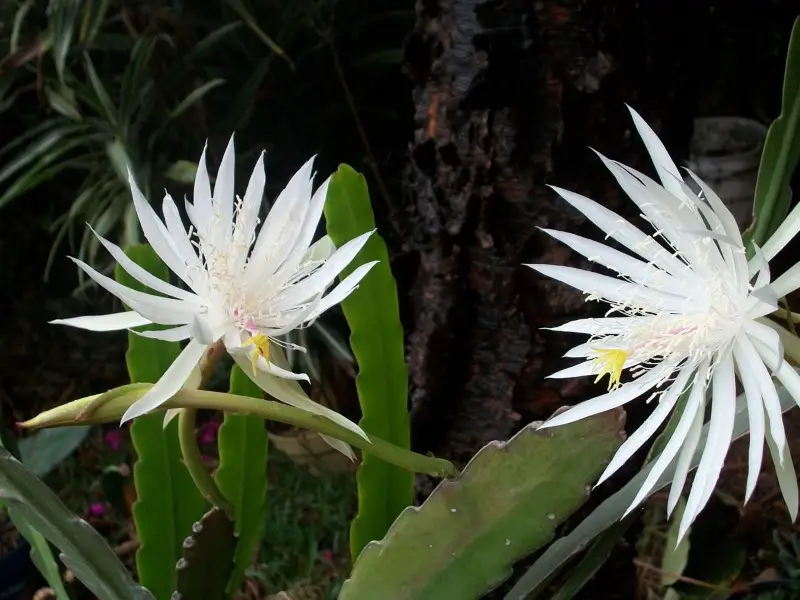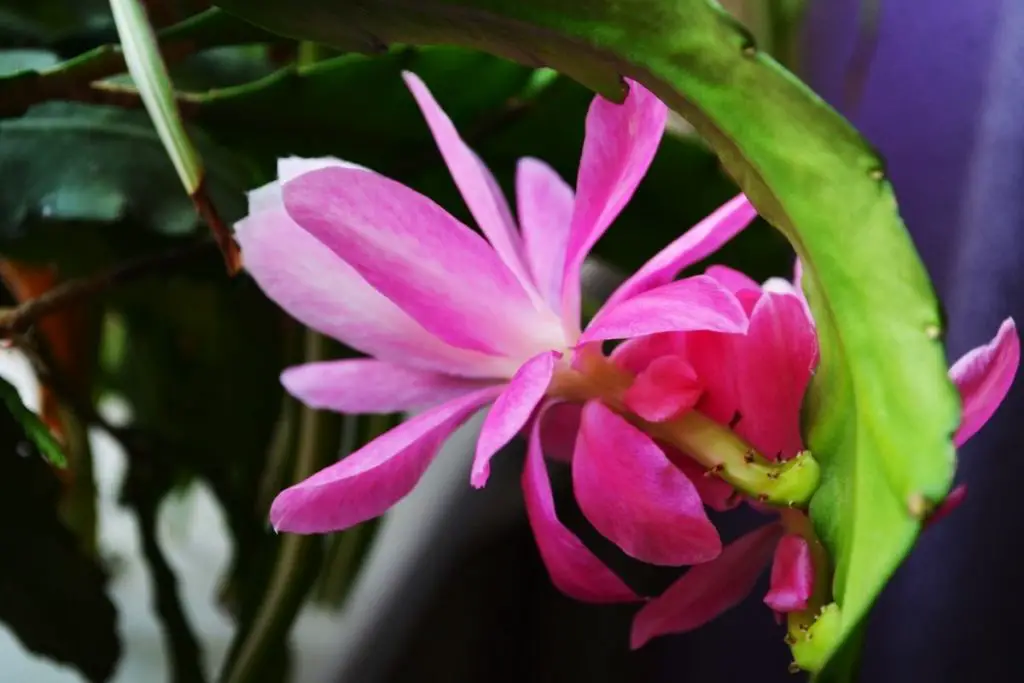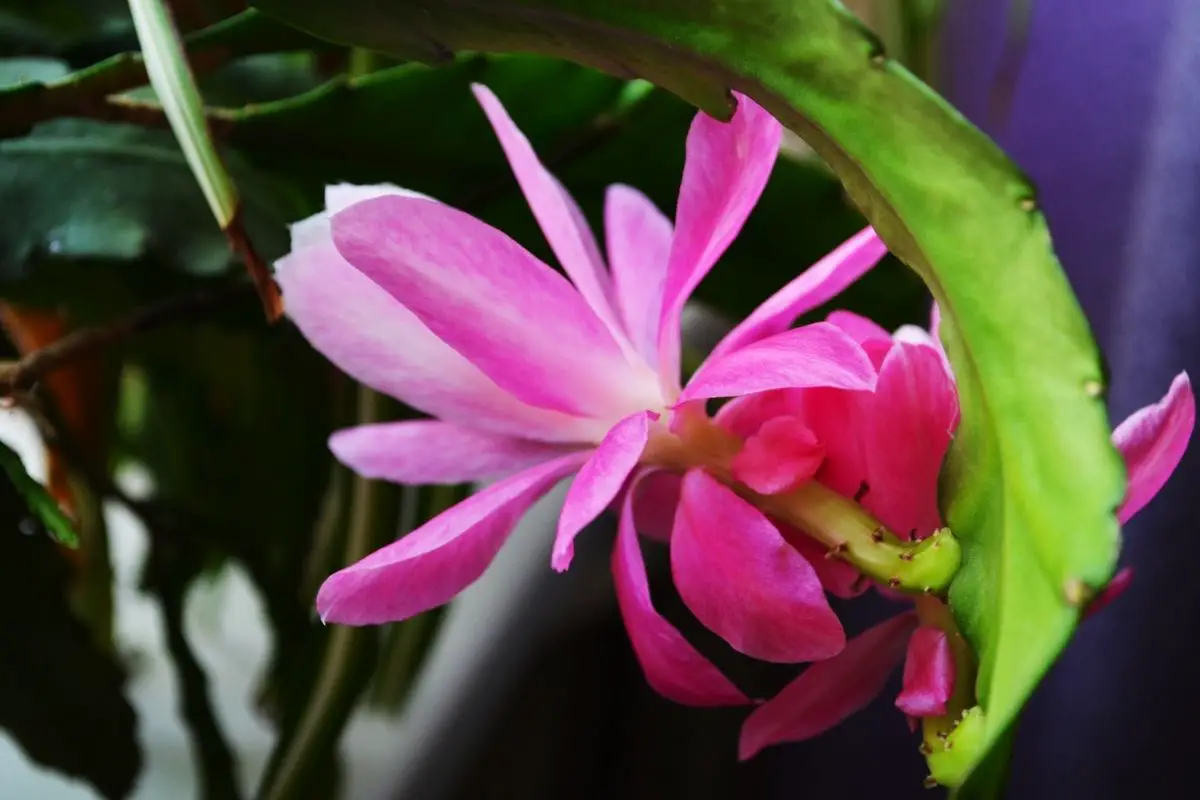The orchid cactus is a pretty houseplant that provides lovely colorful blooms to brighten up your days during the cooler months. These cacti are known as epiphytic plants because, in their natural habitat, they would normally grow in the branch crotches of larger trees.
Epiphyllums are relatively easy to grow if you understand their very specific water requirements. Once you know how to care for them correctly, you’ll be astounded by how easy they are to grow.
Epiphyllums are excellent for growing in hanging baskets and will put on their floral display starting in early winter until spring. The orchid cactus flowers only last a few days fully open but they’ll stay on the plant for about a week or more. Even though these plants originate from tropical forests, they’ll flower better if they’re exposed to cooler temperatures and low light periods.
History
The name, Epiphyllum, comes from the Greek words “Epi” meaning on or upon, and “Phyllon” which means leaf. Therefore, the name of these plants means “upon the leaf”. The reason for this naming is that early botanists had the belief that the flowers grew on the leaf.
In reality, what botanists believe to be leaves, are actually the stems of the plant, and each flower is produced on the end of one of these stems.
Epiphyllums are naturally found in central and south America as well as Mexico. Most of the plants available today are cultivars or hybrids of the original species.
Plant Facts
| Scientific name | Epiphyllum sp. |
| Common names | Orchid cacti, leaf cacti, climbing cactiQueen of the nightLady of the night |
| Genus | Epiphyllum |
| Family | Cactaceae |
| Height | 3 to 10 feet |
| Width | 1 to 3 feet |
| USDA Plant Hardiness Zone | 10 to 11 |
| Origin | South and Central America, Mexico, Caribbean Islands |
| Flower colors | Pink, white, red, orange, purple & yellow |
| Blooming season | Winter and Spring |
| Plant/Flower special features | Produces edible fruit & has no thorns |
How to Plant and Grow Epiphyllum Cactus
The orchid cactus is best grown in a pot and does really well in a hanging pot where the stems can trail down over the edges. The plant should be positioned in filtered light and prefers a little morning sun. It should be protected from the hotter afternoon sun.
Epiphyllums prefer cooler temperatures and need some exposure to temperatures around 50 to 60 degrees Fahrenheit early in winter in order for them to bloom. However, these plants won’t tolerate temperatures below 35 degrees Fahrenheit.
Like all cacti and succulents, they have very specific water requirements and must not be overwatered as this will cause the plant to rot. However, they don’t like to dry out completely either. Therefore, it’s important to keep the top layer of the soil moist but not too wet.

How to Propagate Epiphyllum
Epiphyllums are best propagated from stem cuttings but they can also be grown from seed. Be aware though, that plants grown from seed take from 4 to 7 years to produce flowers.
Growing Epiphyllum from cuttings:
- In Spring or late summer, select a healthy piece of the stem around 4 to 9 inches long and cut just under a segment.
- Leave this in a warm, dry place for a few days until the cut end starts to callous.
- Fill a growing tray with some quality cactus growing medium.
- Insert the calloused end of the stem pieces into the growing mix. Around 1 to 2 inches deep is best.
- Spray the top of the mix with water and remember to keep it constantly moist.
- Place in a warm spot, out of direct sunlight, with a temperature range of 65 to 75 degrees Fahrenheit.
- It will usually take around 3 to 6 weeks for the cuttings to produce roots.
- Once these cuttings have developed roots, you can pot them up into individual pots. If these cuttings were taken in Spring, the plants should produce their first flowers in the winter.
Growing Epiphyllum from seed:
- You should sow seeds in spring and summer.
- Fill a tray with good quality cacti mix.
- Sprinkle the seed over the top of the mix.
- Spray with water to moisten the mix.
- You can cover the seeds with a thin layer of sand.
- Use a plant cloche or clear plastic bag to cover the tray.
- Keep the tray in a warm spot at a temperature of around 70 degrees Fahrenheit.
- Once the seeds have germinated, remove the plastic cover.
- Make sure to keep the growing mix nice and moist but not too wet.
- Once the little seedlings are large enough to handle, you can pick them out and plant them in their individual pots.

Care and Maintenance
Caring for your orchid cactus is not difficult. It doesn’t require a lot of fertilizer or too much attention. These plants are also relatively free from pests and diseases as long as you get the watering right and they’re grown indoors.
Soil
Like all cacti, Epiphyllums require an open, free-draining mix. You can use either a commercially available cacti mix with a little added organic compost or make your own.
A good recipe is to mix equal parts of organic compost or coco fiber with good quality builder’s sand and perlite. This should provide the ideal mixture for good drainage.
Make sure that the mix you use is slightly acidic with a pH level below 6.
Water
Getting the watering requirements correct for these plants is really important if you want them to grow and thrive. They must not be overwatered, however, they don’t like to dry out either.
In most situations, you can water your orchid cactus around once a week during the warmer months but it might only need watering once every ten days or less often in the winter. Most importantly, don’t ever let your plants stand in water as they don’t like having wet feet.
The best way to determine if your cactus needs water is to feel the top layer of the soil with your finger. Just poke your finger into the soil up to the first joint. If the soil feels dry, then the plant needs some water. If the soil feels moist, then check it again the following day.
When you water your Epiphyllum, give it a good soaking but allow all the excess water to drain out. If you’re growing in hanging pots with saucers, it’s better to remove the saucer and water your plant in the sink or the tub.
This ensures that the plant roots get enough water but that they’re not left sitting in wet soil. Overly wet roots are susceptible to a variety of fungal diseases that may eventually kill the plant.
If you’re really concerned about making sure that you get the watering right, you can purchase a moisture meter at your local garden center. This allows you to easily check the moisture level in the soil.
Fertilizer
Epiphyllum cacti don’t require a lot of fertilizer but do benefit from some slow-release pellets applied in spring and summer. Try not to add fertilizer while the plants are flowering.
If you want to promote good flowering, make sure that you select a fertilizer that contains a good amount of potassium.
Sunlight
The plants will benefit from a little indirect morning sunlight but need protection from the hot sun at noon or in the afternoon. A north-facing window that receives morning sun is an ideal spot to place your orchid cactus.
Temperature and Humidity
The orchid cactus prefers cooler temperatures. The ideal temperature range is from 50 to 60 degrees Fahrenheit. It’s important not to expose the plant to really cold temperatures below 35 degrees Fahrenheit as this will cause the plant to die.
Epiphyllum cactus will also appreciate a little humidity as they grow naturally in tropical forests. If the air inside your home is particularly dry, you can increase the humidity by placing a bowl of water near the plant. You could also use a humidifier in the room to increase the overall humidity level.
Pruning
These plants don’t require a lot of pruning. However, if the stems do become overly long, you can safely trim them back a little. You’ll find that new shoots will grow from where you’ve made the cut. If you do this strategically, it’s a good way to shape the appearance of your plant.
Pest and disease
Although not common, Epiphyllums can be attacked by common houseplant pests such as aphids, mealybugs, and red spider mites. All of these can easily be controlled by using an insecticidal soap spray.
Probably the most common disease that may affect your orchid cactus is fungal root rot. However, this can be avoided by ensuring that your plant is never overwatered and that the roots are not allowed to sit in water.
Uses of Epiphyllum
The stems of the orchid cactus have antibacterial properties and have also been used to treat cardiac problems. In addition, the plant does produce edible fruit that tastes a little like passionfruit.
Common Varieties and Cultivars
Epiphyllums are available in a large range of varieties, cultivars, and hybrids. There are some Epiphyllum species that even only bloom at night.
Common Epiphyllum varieties include:
- Epiphyllum hookeri
- Epiphyllum Pegasus
- Epiphyllum anguliger
- Epiphyllum laui
- Epiphyllum oxypetalum
- Epiphyllum crenatum
- Epiphyllum pumilum
Conclusion
The orchid cactus is a popular houseplant that is easy to grow. It’s ideally suited to hanging baskets to allow the stems to trail down over the edge of the pot.
This plant prefers cooler temperatures but does like some humidity. It requires minimal maintenance but must be watered correctly. The plant likes to be kept moist but must not be overwatered. It usually only requires watering once a week in the warmer months or when the top of the soil feels dry.
The flowers appear at the ends of the stems from early winter to spring and these can be quite showy. Often these flowers only last a few days before they close up and eventually fall off.
Epiphyllums are easy to propagate from stem cuttings or seeds. Plants propagated from cuttings should flower the following year. However, those grown from seed may take around 4 to 7 years to produce their stunning flowers.
~ image source: depositphotos/1980monako

